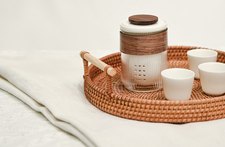Customize your system tray with YAD
Bespoke System Tray

© Photo by Suhyeon Choi on Unsplash
YAD lets you customize your system tray with one-line Bash tray scripts.
My goal was to find a simple way to group together my favorite apps and web pages into a system tray item. There are a number of different approaches to this, but for my requirements I found that the YAD (Yet Another Dialog) tool [1] gave me everything that I needed, and I could do it all with just one line of Bash script.
In this article, I will introduce Bash tray scripts with three examples. The first example will show how to create tray scripts that put Linux diagnostic data into both custom dialogs and terminal windows. In the second example, I will add pop-up browser windows to a right-click submenu. The final example will look at how to toggle the tray icon, command, and tooltip with simulated weather conditions.
Getting Started
There are a number of different tools for creating system tray applications, such as AllTray and KDocker. For my projects, I prefer YAD because it lets you create custom dialogs and it supports dynamic changes to the tray features. YAD is a command-line dialog tool very similar to Zenity [2], but with some added features such as system tray support and a more complete dialog functionality.
[...]
Buy this article as PDF
(incl. VAT)
Buy Linux Magazine
Subscribe to our Linux Newsletters
Find Linux and Open Source Jobs
Subscribe to our ADMIN Newsletters
Support Our Work
Linux Magazine content is made possible with support from readers like you. Please consider contributing when you’ve found an article to be beneficial.

News
-
Say Goodbye to Middle-Mouse Paste
Both Gnome and Firefox have proposed getting rid of a long-time favorite Linux feature.
-
Manjaro 26.0 Primary Desktop Environments Default to Wayland
If you want to stick with X.Org, you'll be limited to the desktop environments you can choose.
-
Mozilla Plans to AI-ify Firefox
With a new CEO in control, Mozilla is doubling down on a strategy of trust, all the while leaning into AI.
-
Gnome Says No to AI-Generated Extensions
If you're a developer wanting to create a new Gnome extension, you'd best set aside that AI code generator, because the extension team will have none of that.
-
Parrot OS Switches to KDE Plasma Desktop
Yet another distro is making the move to the KDE Plasma desktop.
-
TUXEDO Announces Gemini 17
TUXEDO Computers has released the fourth generation of its Gemini laptop with plenty of updates.
-
Two New Distros Adopt Enlightenment
MX Moksha and AV Linux 25 join ranks with Bodhi Linux and embrace the Enlightenment desktop.
-
Solus Linux 4.8 Removes Python 2
Solus Linux 4.8 has been released with the latest Linux kernel, updated desktops, and a key removal.
-
Zorin OS 18 Hits over a Million Downloads
If you doubt Linux isn't gaining popularity, you only have to look at Zorin OS's download numbers.
-
TUXEDO Computers Scraps Snapdragon X1E-Based Laptop
Due to issues with a Snapdragon CPU, TUXEDO Computers has cancelled its plans to release a laptop based on this elite hardware.

